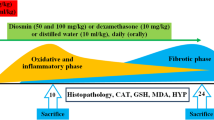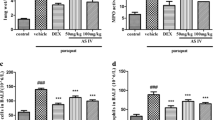Abstract
This study aimed to investigate the protective effects of apigenin against paraquat (PQ)-induced acute lung injury (ALI) in mice. Male Kunming mice were randomly divided into five groups: group 1 (control), group 2 (PQ), group 3 (PQ + apigenin 25 mg/kg), group 4 (PQ + apigenin 50 mg/kg), and group 5 (PQ + apigenin 100 mg/kg). The PQ + apigenin group received apigenin by gavage daily for consecutive 7 days, respectively, while the mice in control and PQ groups were given an equivalent volume of saline. We detected the lung wet/dry weight ratios and the histopathology of the lung. The levels of interleukin-6 (IL-6), tumor necrosis factor-alpha (TNF-α), malondialdehyde (MDA), myeloperoxidase (MPO), superoxide dismutase (SOD), and glutathione peroxidase (GSH-Px) were determined using enzyme-linked immunosorbent assay (ELISA) kits. The activity of nuclear factor (NF)-κB was also determined. The results indicated that apigenin administration decreased biochemical parameters of inflammation and oxidative stress, and improved oxygenation and lung edema in a dose-dependent manner. These protective effects of apigenin were associated with inhibition of NF-κB. In conclusion, apigenin reduces PQ-induced ALI by inhibition of inflammation and oxidative stress.





Similar content being viewed by others
References
Tortorelli, M.C., D.A. Hernández, G. Rey Vázquez, and A. Salibián. 1990. Effects of paraquat on mortality and cardiorespiratory function of catfish fry Plecostomus commersoni. Archives of Environmental Contamination and Toxicology 19(4): 523–529.
Bromilow, R.H. 2004. Paraquat and sustainable agriculture. Pest Management Science 60(4): 340–349.
Chen, J., T. Zeng, Y. Bi, Z. Zhong, K. Xie, and X. Zhao. 2013. Docosahexaenoic acid (DHA) attenuated paraquat induced lung damage in mice. Inhalation Toxicology 25(1): 9–16.
Sabzghabaee, A.M., N. Eizadi-Mood, K. Montazeri, A. Yaraghi, and M. Golabi. 2010. Fatality in paraquat poisoning. Singapore Medical Journal 51(6): 496–500.
Zerin, T., Y.S. Kim, S.Y. Hong, and H.Y. Song. 2012. Protective effect of methylprednisolone on paraquat-induced A549 cell cytotoxicity via induction of efflux transporter, P-glycoprotein expression. Toxicology Letters 208(2): 101–107.
Dinis-Oliveira, R.J., P.G. de Pinho, L. Santos, et al. 2009. Postmortem analyses unveil the poor efficacy of decontamination, anti-inflammatory and immunosuppressive therapies in paraquat human intoxications. PLoS One 4(9): e7149.
Dinis-Oliveira, R.J., J.A. Duarte, A. Sánchez-Navarro, F. Remiao, M.L. Bastos, and F. Carvalho. 2008. Paraquat poisonings: mechanisms of lung toxicity, clinical features, and treatment. Critical Reviews in Toxicology 38(1): 13–71.
Tomita, M., T. Okuyama, H. Katsuyama, et al. 2007. Mouse model of paraquat-poisoned lungs and its gene expression profile. Toxicology 231(2–3): 200–209.
Grommes, J., and O. Soehnlein. 2011. Contribution of neutrophils to acute lung injury. Molecular Medicine 17(3–4): 293–307.
Tao, W., Y.S. Shu, Q.B. Miao, and Y.B. Zhu. 2012. Attenuation of hyperoxia-induced lung injury in rats by adrenomedullin. Inflammation 35(1): 150–157.
Tao, W., Q.B. Miao, Y.B. Zhu, and Y.S. Shu. 2012. Inhaled neutrophil elastase inhibitor reduces oleic acid-induced acute lung injury in rats. Pulmonary Pharmacology & Therapeutics 25(1): 99–103.
Dang, H., S. Wang, L. Yang, F. Fang, and F. Xu. 2012. Upregulation of Shh and Ptc1 in hyperoxia-induced acute lung injury in neonatal rats. Molecular Medicine Reports 6(2): 297–302.
Margolis, A.M., S. Porasuphatana, and G.M. Rosen. 2000. Role of paraquat in the coupling of nitric oxide synthase. Biochimica et Biophysica Acta 1524(2–3): 253–257.
Lin, Y.C., Y.S. Lai, and T.C. Chou. 2013. The protective effect of alpha-lipoic acid in lipopolysaccharide-induced acute lung injury is mediated by heme oxygenase-1. Evidence-Based Complementary and Alternative Medicine 2013: 590363.
Chen, J., Y. Mo, C.F. Schlueter, and G.W. Hoyle. 2013. Inhibition of chlorine-induced pulmonary inflammation and edema by mometasone and budesonide. Toxicology and Applied Pharmacology 272(2): 408–413.
Lefort, É.C., and J. Blay. 2013. Apigenin and its impact on gastrointestinal cancers. Molecular Nutrition & Food Research 57(1): 126–144.
Rice-Evans, C. 2001. Flavonoid antioxidants. Current Medicinal Chemistry 8(7): 797–807.
Patel, D., S. Shukla, and S. Gupta. 2007. Apigenin and cancer chemoprevention: progress, potential and promise (review). International Journal of Oncology 30(1): 233–245.
Shukla, S., and S. Gupta. 2010. Apigenin: a promising molecule for cancer prevention. Pharmaceutical Research 27(6): 962–978.
Fu, M.S., B.J. Zhu, and D.W. Luo. 2014. Apigenin prevents TNF-alpha induced apoptosis of primary rat retinal ganglion cells. Cellular and Molecular Biology (Noisy-le-Grand, France) 60(4): 37–42.
Wang, T., X. Zhang, and J.J. Li. 2002. The role of NF-kappaB in the regulation of cell stress responses. International Immunopharmacology 2(11): 1509–1520.
Kang, J.L., H.W. Lee, H.S. Lee, et al. 2001. Genistein prevents nuclear factor-kappa B activation and acute lung injury induced by lipopolysaccharide. American Journal of Respiratory and Critical Care Medicine 164(12): 2206–2212.
Wright, J.G., and J.W. Christman. 2003. The role of nuclear factor kappa B in the pathogenesis of pulmonary diseases: implications for therapy. American Journal of Respiratory Medicine 2(3): 211–219.
Xia, Y.F., B.Q. Ye, Y.D. Li, et al. 2004. Andrographolide attenuates inflammation by inhibition of NF-kappa B activation through covalent modification of reduced cysteine 62 of p50. Journal of Immunology 173(6): 4207–4217.
Ghosh, S., M.J. May, and E.B. Kopp. 1998. NF-kappa B and Rel proteins: evolutionarily conserved mediators of immune responses. Annual Review of Immunology 16: 225–260.
Li, Q., and I.M. Verma. 2002. NF-kappa B regulation in the immune system. Nature Reviews Immunology 2(10): 725–734.
Johansson, M.W., M. Patarroyo, F. Oberg, A. Siegbahn, and K. Nilson. 1997. Myeloperoxidase mediates cell adhesion via the alpha M beta 2 integrin (Mac-1, CD11b/CD18). Journal of Cell Science 110(Pt 9): 1133–1139.
Erten, S.F., A. Kocak, I. Ozdemir, S. Aydemir, A. Colak, and B.S. Reeder. 2003. Protective effect of melatonin on experimental spinal cord ischemia. Spinal Cord 41(10): 533–538.
Shaafi, S., M. Afrooz Razm, B. Hajipour, A. Dadadshi, M.M. Hosseinian, and A. Khodadadi. 2011. Anti-oxidative effect of lipoic acid in spinal cord ischemia/reperfusion. Medical Principles and Practice 20(1): 19–22.
Qian, H., and D. Liu. 1997. The time course of malondialdehyde production following impact injury to rat spinal cord as measured by microdialysis and high pressure liquid chromatography. Neurochemical Research 22(10): 1231–1236.
Acknowledgments
This research received no specific grant from any funding agency in the public, commercial, or not-for-profit sectors.
Author information
Authors and Affiliations
Corresponding author
Ethics declarations
Conflict of Interest
The authors declare that they have no conflict of interest.
Ethics Statement
All animal experiments were performed in accordance with the Institutional Animal Care Committee of Yuhuangding Hospital.
Rights and permissions
About this article
Cite this article
Luan, RL., Meng, XX. & Jiang, W. Protective Effects of Apigenin Against Paraquat-Induced Acute Lung Injury in Mice. Inflammation 39, 752–758 (2016). https://doi.org/10.1007/s10753-015-0302-2
Published:
Issue Date:
DOI: https://doi.org/10.1007/s10753-015-0302-2




